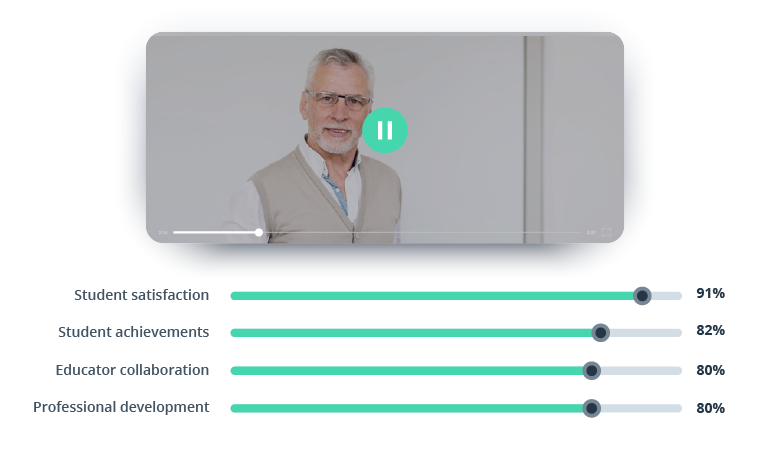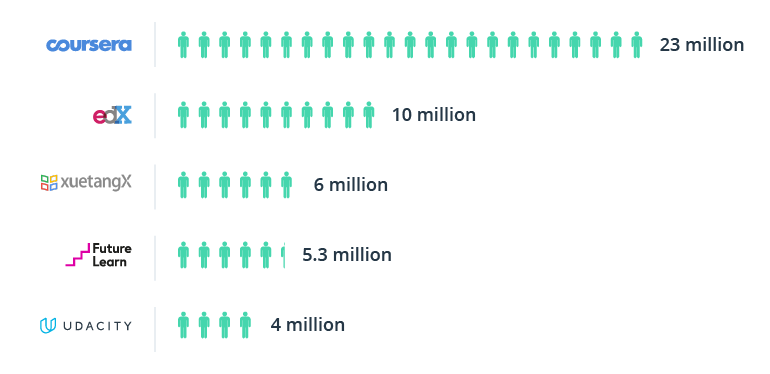The rapid growth of technology is quickly changing the education sector. Incorporating technologies makes teaching and learning more effective and engaging. Technology also solves common administrative challenges faced by educational providers and institutions.
Technologies such as virtual learning environments (VLEs), online courses, and virtual classrooms all help learners and institutions keep pace with the changing world of education. However, new technologies are constantly emerging and disrupting current processes.
Keeping up with the latest trends makes it difficult to know how to implement technology in a way that meets your institution’s specific requirements. Follow this guide, explore the future of education and technology, and learn how working with a strategic partner with EdTech expertise can make all the difference when it comes to developing EdTech solutions for your industry.
Companies that invest in employees’ learning experiences outperform those that don’t
OECD countries devote as much as 11.3% of public spending to education, which includes spending for technology. Educational institutions need the best resources to teach students relevant and high-demand skills. In workplaces, comprehensive training programs can lead to 218% higher revenue per employee. Organizations of all sizes must establish effective training departments to stay competitive. Employers that spend $1,500 per employee per year on training achieve improvements in profit margins of around 24%. However, there’s no one-size-fits-all solution when it comes to training your workforce.

Source: HBR.org – The employees experience advantage by Jacob Morgan
Gen Z and technology in education
As generations change, the approach to teaching changes with them. This is evident in all types of schools, colleges, and employment training programs. Educational resources and programs must match the modern generation’s expectations and learning styles.
Millennials represent the largest generation in the workforce, while Gen Z (those born after the mid-1990s) is the fastest-growing generation.

Learning methods used by Gen Z employees aren’t necessarily the same ones used by older generations. Younger learners are more likely to use the internet than books when looking for quick answers. Governments, employers, and institutions must adapt to this reality. It’s well known that the internet is a powerful learning technology and taking devices away from students during lessons may be counterproductive.
Younger generations often have shorter attention spans than older generations. With a huge amount of content available at their fingertips 24/7, learners easily dismiss content that doesn’t hold their attention. Learners want quick answers to questions and prefer bite-sized content. Content should also be available anytime, anywhere so learners can access it at their own pace. Multimedia content is more popular with younger learners than simple text and is more likely to engage them.
However, search engines like Google don’t always give comprehensive answers. This is especially true in higher education, where independent research skills are essential. To answer specific queries, it’s best to use internal knowledge management systems or electronic libraries. Institutions must continue to invest in these resources alongside the latest technologies.
Changes in learning habits (such as more personalized, self-directed learning) are transforming teaching. While past generations saw the teacher as a guru at the front of the class, modern approaches are shifting the focus to students as the main participants in the learning process. These are often known as flipped classrooms, and future schools are likely to feature them heavily.
EdTech trends
Academics and educational institutions must change their approaches to suit changes in learning habits. Examples can be found in past innovations and emerging trends, and future technologies are also sure to reflect this. Technology has long played a critical role in transforming the education sector to meet students’ changing needs. Here are some examples of education technology trends past, present, and future.
1. Interactive whiteboards
Interactive whiteboards became popular in the 1990s as a way to combine the functionality of a traditional whiteboard with computer technology. Allowing users to interact with digital content using touch or pen has been found to increase engagement.
With features like annotation, multimedia integration, and internet connectivity, interactive whiteboards promote active participation and improve information retention. Interactive whiteboards have proven to be invaluable tools for enhancing communication, collaboration, and learning experiences in classrooms.
2. Cloud technology
Cloud computing provides convenient access to resources and collaboration tools. It allows learners and teachers to store and access data, documents, and applications from any device with internet access.
Cloud-based learning management systems enable seamless communication and online collaboration, fostering remote and personalized learning. Cloud technology has expanded educational opportunities, improved efficiency, and transformed traditional classroom practices.
3. Video conferencing tools
Video conferencing tools enable the creation of virtual classrooms, allowing students to participate in learning from any location if they have a device with internet access. While adoption of video conferencing tools rose sharply during the recent pandemic, distance learning remains a widespread practice.
Blended learning, where educational courses include both in-person classes and online resources, has also become a prominent trend. During video classes, students can receive mentorship while also researching the topic on the internet in another window. Video conferencing tools with easily accessible multimedia content have been shown to increase engagement.
Educational institutions say video increases:

Source: EDU-TECH, “How Technology is Shaping the Future of Education”
4. eLearning platforms and tools
As one of the most significant inventions of the last century, the internet has influenced countless sectors in ways that cannot be overstated. The education sector is no exception, and eLearning has become a cornerstone of modern teaching and learning. eLearning platforms and tools include virtual learning environments (VLEs) like Moodle, Blackboard, and Canvas. eLearning platforms focus on specific knowledge and skills, or present a variety of courses that are accessible to a wide audience. They also integrate into existing systems so content can be customized to suit specific organizational requirements.
eLearning platforms aren’t just for schools and other educational institutions. Companies can adapt a platform to the specific learning needs of employees to teach them how to use a particular type of software or learn the skills required for a new role. Some open-source eLearning platforms like Moodle are used to create courses with a personalized touch. Other eLearning platforms use multiple features to deliver a custom experience to learners.
5. Massive open online courses (MOOCs)
MOOCs offer a wide array of resources to help learners acquire any skill they want. Platforms like edX, Coursera, and Udacity exemplify how education is becoming more accessible. By enrolling students in relevant courses, organizations save significant time and effort that would otherwise be spent on developing their own educational materials. Many renowned educational institutions globally are developing courses to share their lecturers’ experiences with a wider audience.
You may have seen ads on social media for MasterClass courses where famous people share their expertise on various topics. For example, David Lynch teaches the art of creative thinking, while Stephen Curry teaches basketball skills. Technology has made it possible for teachers like these to share their knowledge on a global scale.
Top five MOOC providers by registered users:

6. Gamification
Gamification is one of the most notable recent trends in education. It involves the use of game elements and mechanics in non-game contexts to make activities more engaging and enjoyable. This includes features like specific objectives, point scoring, and leaderboards. Gamification can be used in a variety of areas, including school, work, fitness apps, and advertising. It adds a sense of competition and enjoyment to tasks, making them more interactive and rewarding.
The conventional wisdom has long been that video gaming is a distraction from more important activities. However, it can actually teach skills like critical thinking, teamwork, and problem-solving. Elements of video gaming are now being incorporated into learning processes. eLearning courses are often gamified, and video games like Minecraft have been used as virtual environments for teaching and learning.
7. Assistive technologies
Teachers and educators often struggle to provide effective learning experiences for students with disabilities. Assistive learning technologies make it easier for these students to learn and participate in education. For example, assistive technologies can make text bigger or read it out loud for students with vision impairments. Other technologies allow learners with limited mobility to control computers or tablets without using their hands.
Text-to-speech tools can help students with disabilities related to speech and communication. Modified keyboards with larger keys are also widely available. Some tools even help learners express themselves using pictures, symbols, or by typing on a special device that speaks for them. Assistive learning technologies are designed to break down barriers and help students become more independent and empowered in their learning.
8. Virtual reality and augmented reality
Like video games, virtual reality (VR) and augmented reality (AR) are typically associated with entertainment and recreation. However, they also have uses in education. Many students are visual or kinesthetic learners who can benefit from visual technology or interactive tools. A study has even shown that learning in VR leads to significantly higher retention of information than learning on a traditional computer or tablet.
As well as teaching, VR and AR can be used to assess students’ knowledge and skills. In industries like medicine, manufacturing, and construction, VR and AR tools are already being used in this way. Medical schools can replace cadavers with precise VR models for skills practice to assess future healthcare workers. Construction workers can also practice using tools in safe virtual environments where accidents have no real-world repercussions. Companies and institutions are even using VR and AR for interactive entrance exams and interviews, as well as on-the-job training.
9. Artificial intelligence, automation, and NLP
Artificial intelligence has notable use cases for personalizing learning. AI tools can provide fast and relevant feedback to learners and encourage self-directed learning. Spending long hours assessing students’ work can be tiresome, and often leads to mistakes. Smart assistants can make this process faster and more accurate. By receiving rapid feedback, students tend to improve faster.
AI tools are capable of predicting the best pathways for individual learners based on behavioral patterns shown during the course. Also, they can automatically create personalized learning plans to meet students’ needs and adapt to each student’s pace. Chatbots like ChatGPT as part of the Generative AI revolution are useful for supporting learners and answering their questions as they interact with educational content.
10. OLED Displays
OLED (organic light-emitting diode) technology has already become widely available commercially. And the technology is continuously developing. OLED displays are used in classrooms. These displays are designed to be much thinner and more flexible than traditional displays used in computer monitors, televisions, and tablets. It’s possible that they could even be as thin as a piece of paper. As this technology progresses, these flexible, paper-thin screens could be as interactive as tablets and mobile phones.
Similar to the way that the arrival of interactive whiteboards created opportunities for improved teaching and learning processes, the adoption of OLED displays is a turning point for the future of technology in the classroom. Students are already using them to take notes, give presentations, and more. Besides the practical benefits of such a portable technology, the replacement of paper products will improve environmental sustainability in education.
11. Smart desks
Another promising technology that echoes the invention of interactive whiteboards is the smart desk. Imagine a surface the size of the top of a desk, but with the interactivity and functionality of a tablet. Companies like Microsoft and Samsung have already developed prototypes, but these have so far been too expensive for widespread production and adoption. However, smart desk technology will likely become more available over the coming years.
The potential of this technology in education is great. Classroom-based group projects will become much easier to carry out, and the need for physical resources like paper and pens will be reduced. With internet connectivity, learners will have the ability to collaborate on desk-based projects with students in other classrooms — or even on the other side of the world.

The future of education technology
What is the future of technology in education? New technology is constantly being developed, but the question remains of how best to use it in education. From design tools for creating engaging content to AI-based content personalization, technology is shaping how people acquire the knowledge they need.
There are many notable benefits of technology in education:
- Increased access to educational resources — Video conferencing tools and educational software enable teachers to reach more students, particularly those unable to attend physical classes. This trend is likely to continue as time goes on.
- Lifelong learning — Rather than the learning process ending when students complete a course, access to educational resources can enable continual learning. Students and employees can carry on learning and developing their skills in their spare time.
- Collaborative learning — Collaborative platforms help learners work together on projects more effectively.
- Improving technological skills — Digital transformation has made IT skills crucial for employment. Incorporating technology into teaching and learning can organically improve learners’ IT skills.
- Increased career opportunities — As a result of improved learning processes and technological skills, learners can improve their skill sets in various fields. Ultimately, this results in more opportunities in the workplace.
Technological innovations are also changing the wider culture of education. Nowadays, the role of a teacher has already started to shift from assessor and supervisor to mentor and expert advisor. Future educational technology is likely to accelerate this trend. As access to resources increases and learning becomes more personalized, teachers will play a more guiding role.
Although learning is becoming more self-directed, that doesn’t mean it will happen in isolation. Educational communities are an increasing trend. Many eLearning platforms offer discussion forums where students can communicate with others on their course. Some platforms even allow discussion with students at other institutions. These communities can help learners share knowledge, generate ideas, and provide encouragement without geographical or time-based limitations.
Cohort-based learning exemplifies this. In this framework, groups of learners start and end a course at the same time. While this sounds more like the traditional classroom-based model than the future of EdTech, technologies can bring these benefits to distance learning. For the best results, education providers should facilitate interaction and collaboration among learners. Some eLearning platforms do this by including live classes and events alongside resources that can be accessed at any time.
Classroom of the future
Technological trends are providing many opportunities for teachers and learners. However, improving education is about more than just adopting the latest technology. In the future classroom, technologies must be implemented in ways that suit each institution and its learners.
To benefit from the future of educational technology, it must be understood. Unfortunately, many institutions lack the in-house technical skills and expertise required. This is where external help can be indispensable. Partnering with a custom software development team can help institutions provide bespoke solutions that match their individual needs.



